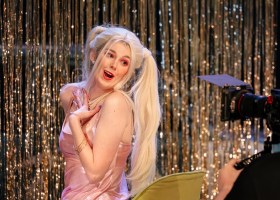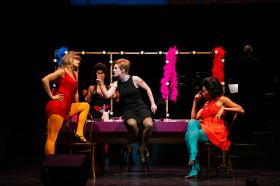Image source: Dancenorth.
To begin with, a joint presentation by two of Australia’s leading regional dance companies is a first and something to applaud for that reason alone. To add to that explanation, it not only has six highly talented dancers from Tasdance and Dance North working collaboratively, having bounced ideas around to shape a very innovative program, it also showcases the choreography of three leading practitioners in the field. The result from an audience viewpoint is an evening of high-energy performances sometimes exciting, always novel and, at the end, extremely moving. So much so that there was a standing ovation on the first night in Cairns.
The first offering, Echo, uses a bare stage with spot lighting into which the dancers gradually move as they explore the possibilities of their movements echoing each other, to the accompaniment of a soundscape marked by percussive highlights and repeated droning sounds. The fluidity of the dancers and its sudden opposite – their stillness – is a technical tour de force, as indeed the whole piece is. The young Taiwanese choreographer, Huang Yi, has taken many of the defining qualities of contemporary dance – fluid movement of the dancers, gesture, abrupt transitions, recurring motifs, use of the floor space as a site for dance movements, and audiovisual technologies of sound and lighting – to produce a visual masterpiece. The dance elements combine with exquisite precision to produce an abstract painting in motion. It could be a Mondrian or a Léger, perhaps, if these had moving elements. Those who like to have a literal interpretation of the dance, or a story, as so often in ballet, will not find what they are looking for here, but those who appreciate the artistry of the dancers, their range of movement and their sheer physicality, will be delighted with it.
The second piece, In, choreographed by Gavin Webber, offers a complete transformation – in that it is more of an improvisation to the accompaniment of rock guitar music in which the dancers release their inner feelings – or their essence, if you like, with the help of a pile of clothing that descends from above and is then donned or shed as the mood takes them and the music dictates. A program note by the choreographer, in a quotation from John Steinbeck, mentions the idea that “there has to be something inside, if only to prevent the skin from collapsing”. Well, this piece aims to show what that inside element is, and it does so with some humour. The audience was given cause to laugh on numerous occasions as shirts, pants and socks were laboriously put on and taken off. At one point the dancers began to throw clothes up into the flies and the scene became a dance of flying garments above echoing the motions of the dancers on the floor. Innovative hardly begins to describe this work, but let me say that it left me filled with admiration for the variety of movement encouraged and encompassed in contemporary dance theatre.
The final piece, A Dance for the Forgotten, choreographed by Raewyn Hill, is very moving, almost a requiem for the victims of the Port Arthur massacre of 1996, remembered as one of the deadliest single person shootings ever. Thirty-five people were killed and twenty-three wounded. They are, presumably, “the forgotten” of this piece, and to underscore that point, the stage becomes a corridor lit from each side by panels of light, giving an effect rather like that of the sun shining through the stained glass windows of a cathedral into the dim interior – but without the colour, just the light from outside. The dancers, clad in black, some in the form of cassocks, some in the shape of black birds of omen, move to the sombre music of Pergoli’s Marian Vespers as re-imagined for the dance by Eden Mulholland. At times the dancers are the priests and the mourners, moving in solemn dignity, and at other times they are the onlookers, startled and scared by the unexpected gunshots coming from nowhere, repeated and repeated in a terrifying sequence. Holding it all together is the majestic and solemn organ and choral music of the Marian Vespers, rising to a crescendo as the piece concludes. I was, to put it mildly, stunned by the totality of the experience, watching the dancers, listening to the music, and appreciating the depth of feeling inherent in the piece. It was a fitting conclusion to a rich and varied program.
I would conclude by adding that the six dancers who made up the ensemble – Sarah Fiddeman, Brianna Kell, and Timothy Walsh of Tasdance, and Alice Hinde, Eryn Mulholland and Andrew Searle of Dance North – all display an amazing stamina and intensity, along with a remarkable range of movement and corporeal shaping. They are a revelation in what the dance is capable of. Suzanne Langer says, in her book, Feeling and Form, that “Art is the creation of forms symbolic of human feeling”. These dancers and the choreographers whose work they interpret are accomplished artists, adept in portraying our deepest and innermost feelings. The program continues in Launceston this week and Hobart next. It is not to be missed.
Rating: 4 ½ out of 5 stars
Threefold: Webber / Hill / Huang Yi
A joint presentation by Dancenorth and Tasdance showcasing the work of choreographers, Huang Yi, Gavin Webber and Raewyn Hill.
Centre of Contemporary Arts, Abbott St, Cairns
www.centre-of-contemporary-arts-cairns.com.au/
15-16 August






